Impact of the Affordable Care Act on Hospitalization Processes
VerifiedAdded on 2022/11/19
|9
|2426
|212
Report
AI Summary
This report delves into the processes of hospitalization under the Affordable Care Act (ACA), comparing and contrasting them with pre-ACA practices. It meticulously examines the patient journey from admission to discharge, covering critical aspects such as aftercare, rehabilitation, and the acquisition of medications. The analysis highlights the differences in healthcare access, insurance coverage, and the overall quality of care before and after the implementation of the ACA. The report addresses how the ACA has impacted various stages of the hospitalization process, including admission criteria, discharge policies, the availability of rehabilitative services, and the accessibility of medications. Furthermore, it explores the financial implications for both patients and healthcare providers, considering the role of insurance coverage and cost-sharing. The study utilizes scholarly references to support its findings, providing a comprehensive overview of the ACA's influence on the healthcare landscape and the experiences of patients during hospitalization.
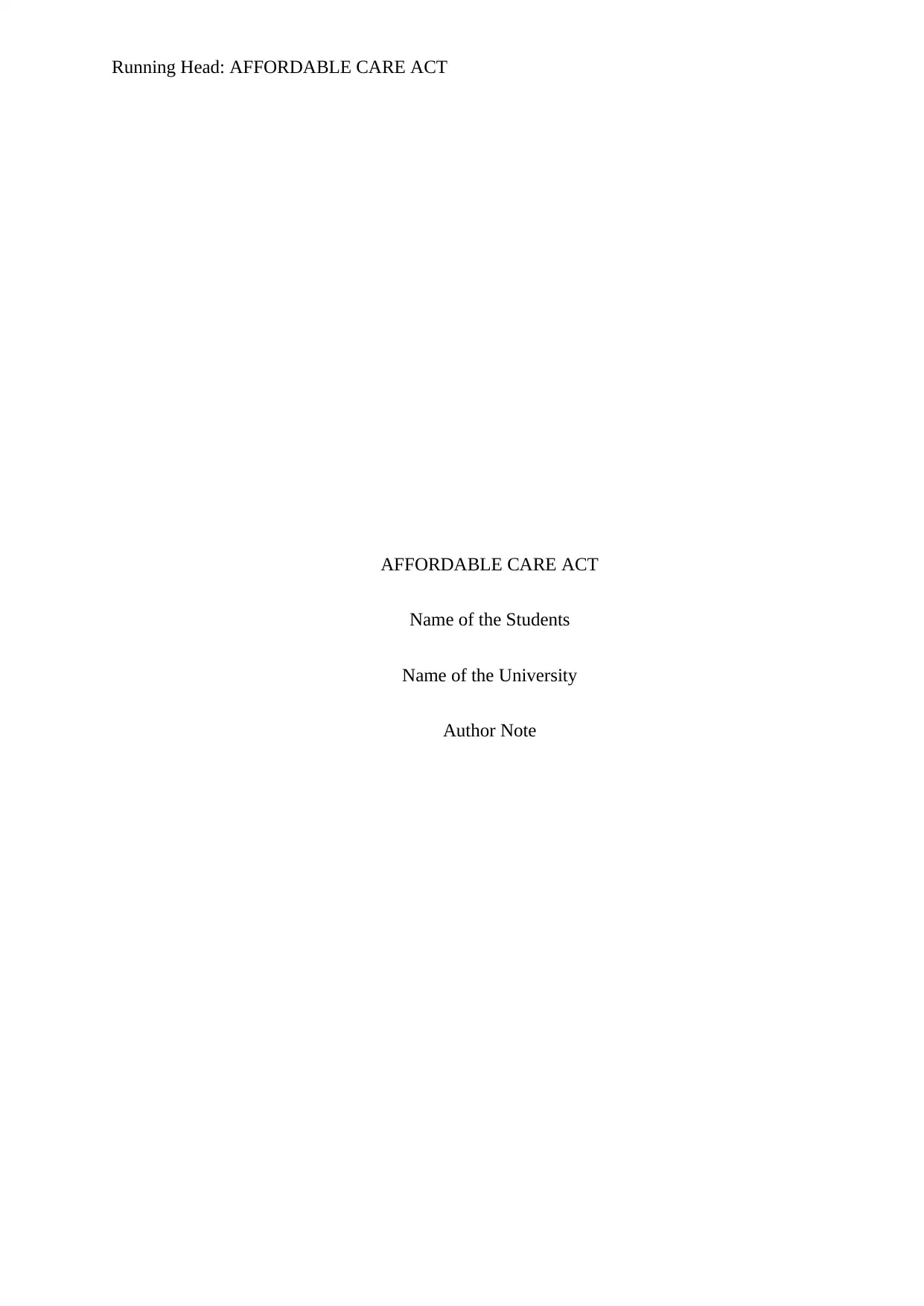
Running Head: AFFORDABLE CARE ACT
AFFORDABLE CARE ACT
Name of the Students
Name of the University
Author Note
AFFORDABLE CARE ACT
Name of the Students
Name of the University
Author Note
Paraphrase This Document
Need a fresh take? Get an instant paraphrase of this document with our AI Paraphraser
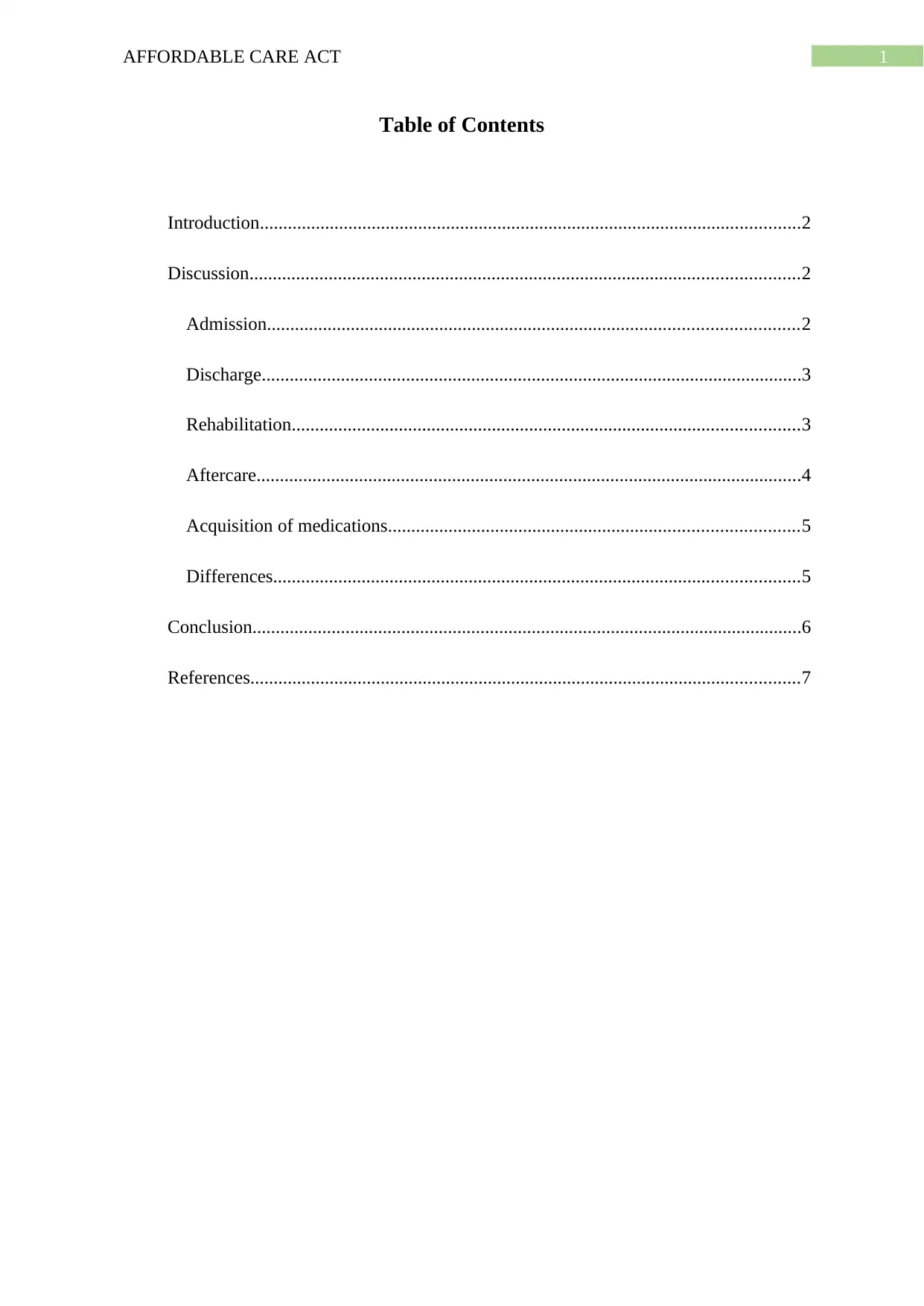
1AFFORDABLE CARE ACT
Table of Contents
Introduction....................................................................................................................2
Discussion......................................................................................................................2
Admission..................................................................................................................2
Discharge....................................................................................................................3
Rehabilitation.............................................................................................................3
Aftercare.....................................................................................................................4
Acquisition of medications........................................................................................5
Differences.................................................................................................................5
Conclusion......................................................................................................................6
References......................................................................................................................7
Table of Contents
Introduction....................................................................................................................2
Discussion......................................................................................................................2
Admission..................................................................................................................2
Discharge....................................................................................................................3
Rehabilitation.............................................................................................................3
Aftercare.....................................................................................................................4
Acquisition of medications........................................................................................5
Differences.................................................................................................................5
Conclusion......................................................................................................................6
References......................................................................................................................7
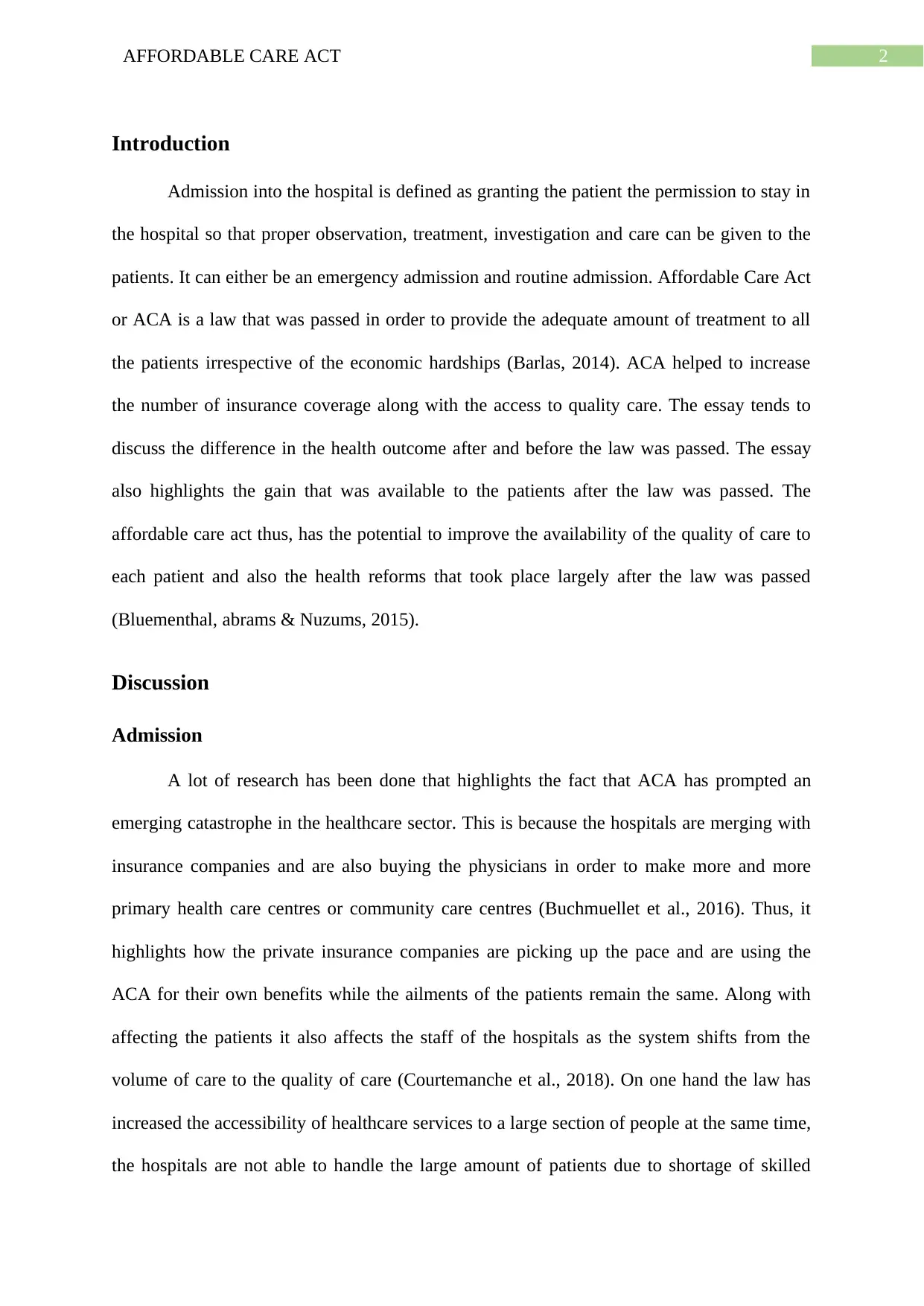
2AFFORDABLE CARE ACT
Introduction
Admission into the hospital is defined as granting the patient the permission to stay in
the hospital so that proper observation, treatment, investigation and care can be given to the
patients. It can either be an emergency admission and routine admission. Affordable Care Act
or ACA is a law that was passed in order to provide the adequate amount of treatment to all
the patients irrespective of the economic hardships (Barlas, 2014). ACA helped to increase
the number of insurance coverage along with the access to quality care. The essay tends to
discuss the difference in the health outcome after and before the law was passed. The essay
also highlights the gain that was available to the patients after the law was passed. The
affordable care act thus, has the potential to improve the availability of the quality of care to
each patient and also the health reforms that took place largely after the law was passed
(Bluementhal, abrams & Nuzums, 2015).
Discussion
Admission
A lot of research has been done that highlights the fact that ACA has prompted an
emerging catastrophe in the healthcare sector. This is because the hospitals are merging with
insurance companies and are also buying the physicians in order to make more and more
primary health care centres or community care centres (Buchmuellet et al., 2016). Thus, it
highlights how the private insurance companies are picking up the pace and are using the
ACA for their own benefits while the ailments of the patients remain the same. Along with
affecting the patients it also affects the staff of the hospitals as the system shifts from the
volume of care to the quality of care (Courtemanche et al., 2018). On one hand the law has
increased the accessibility of healthcare services to a large section of people at the same time,
the hospitals are not able to handle the large amount of patients due to shortage of skilled
Introduction
Admission into the hospital is defined as granting the patient the permission to stay in
the hospital so that proper observation, treatment, investigation and care can be given to the
patients. It can either be an emergency admission and routine admission. Affordable Care Act
or ACA is a law that was passed in order to provide the adequate amount of treatment to all
the patients irrespective of the economic hardships (Barlas, 2014). ACA helped to increase
the number of insurance coverage along with the access to quality care. The essay tends to
discuss the difference in the health outcome after and before the law was passed. The essay
also highlights the gain that was available to the patients after the law was passed. The
affordable care act thus, has the potential to improve the availability of the quality of care to
each patient and also the health reforms that took place largely after the law was passed
(Bluementhal, abrams & Nuzums, 2015).
Discussion
Admission
A lot of research has been done that highlights the fact that ACA has prompted an
emerging catastrophe in the healthcare sector. This is because the hospitals are merging with
insurance companies and are also buying the physicians in order to make more and more
primary health care centres or community care centres (Buchmuellet et al., 2016). Thus, it
highlights how the private insurance companies are picking up the pace and are using the
ACA for their own benefits while the ailments of the patients remain the same. Along with
affecting the patients it also affects the staff of the hospitals as the system shifts from the
volume of care to the quality of care (Courtemanche et al., 2018). On one hand the law has
increased the accessibility of healthcare services to a large section of people at the same time,
the hospitals are not able to handle the large amount of patients due to shortage of skilled
⊘ This is a preview!⊘
Do you want full access?
Subscribe today to unlock all pages.

Trusted by 1+ million students worldwide
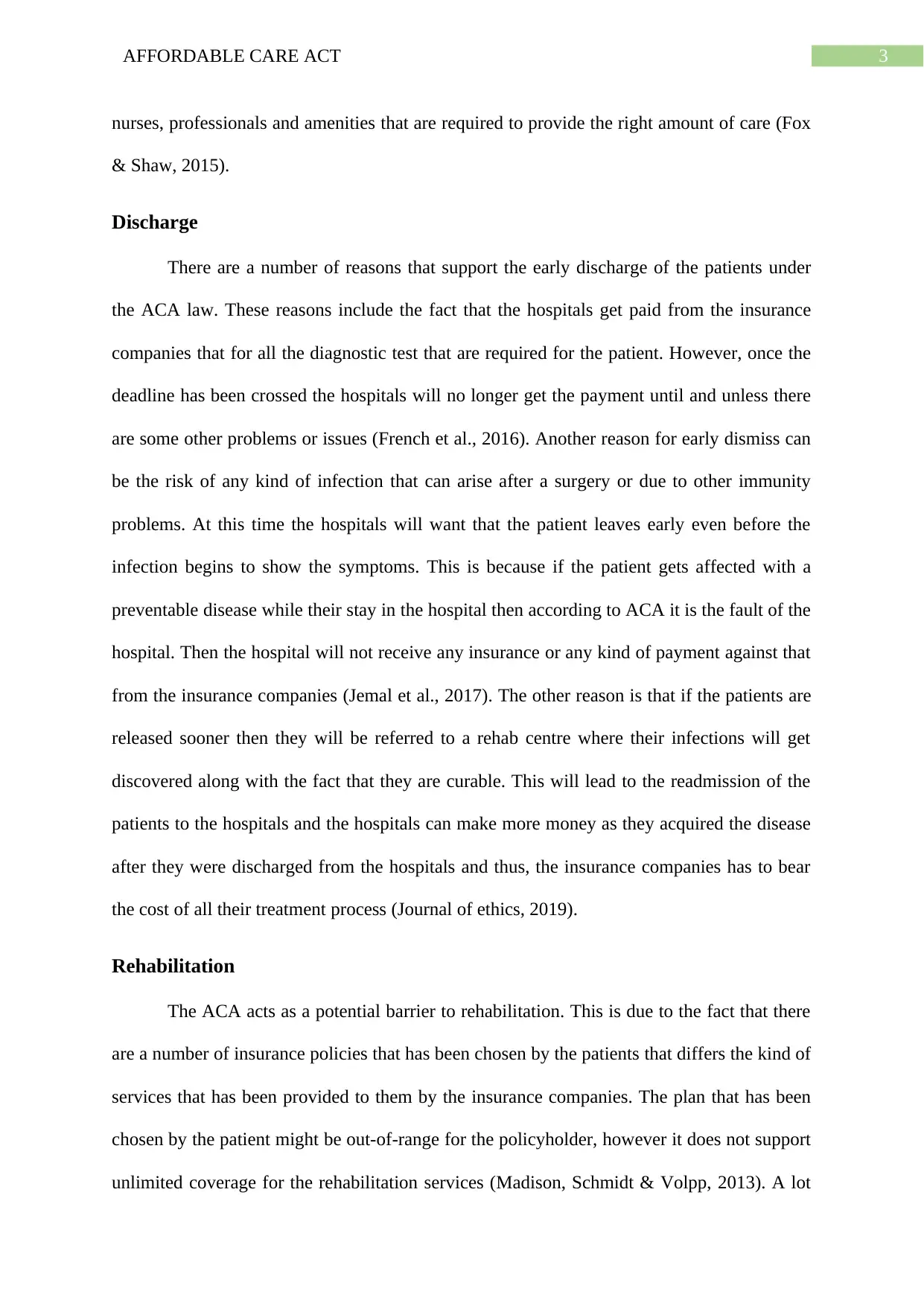
3AFFORDABLE CARE ACT
nurses, professionals and amenities that are required to provide the right amount of care (Fox
& Shaw, 2015).
Discharge
There are a number of reasons that support the early discharge of the patients under
the ACA law. These reasons include the fact that the hospitals get paid from the insurance
companies that for all the diagnostic test that are required for the patient. However, once the
deadline has been crossed the hospitals will no longer get the payment until and unless there
are some other problems or issues (French et al., 2016). Another reason for early dismiss can
be the risk of any kind of infection that can arise after a surgery or due to other immunity
problems. At this time the hospitals will want that the patient leaves early even before the
infection begins to show the symptoms. This is because if the patient gets affected with a
preventable disease while their stay in the hospital then according to ACA it is the fault of the
hospital. Then the hospital will not receive any insurance or any kind of payment against that
from the insurance companies (Jemal et al., 2017). The other reason is that if the patients are
released sooner then they will be referred to a rehab centre where their infections will get
discovered along with the fact that they are curable. This will lead to the readmission of the
patients to the hospitals and the hospitals can make more money as they acquired the disease
after they were discharged from the hospitals and thus, the insurance companies has to bear
the cost of all their treatment process (Journal of ethics, 2019).
Rehabilitation
The ACA acts as a potential barrier to rehabilitation. This is due to the fact that there
are a number of insurance policies that has been chosen by the patients that differs the kind of
services that has been provided to them by the insurance companies. The plan that has been
chosen by the patient might be out-of-range for the policyholder, however it does not support
unlimited coverage for the rehabilitation services (Madison, Schmidt & Volpp, 2013). A lot
nurses, professionals and amenities that are required to provide the right amount of care (Fox
& Shaw, 2015).
Discharge
There are a number of reasons that support the early discharge of the patients under
the ACA law. These reasons include the fact that the hospitals get paid from the insurance
companies that for all the diagnostic test that are required for the patient. However, once the
deadline has been crossed the hospitals will no longer get the payment until and unless there
are some other problems or issues (French et al., 2016). Another reason for early dismiss can
be the risk of any kind of infection that can arise after a surgery or due to other immunity
problems. At this time the hospitals will want that the patient leaves early even before the
infection begins to show the symptoms. This is because if the patient gets affected with a
preventable disease while their stay in the hospital then according to ACA it is the fault of the
hospital. Then the hospital will not receive any insurance or any kind of payment against that
from the insurance companies (Jemal et al., 2017). The other reason is that if the patients are
released sooner then they will be referred to a rehab centre where their infections will get
discovered along with the fact that they are curable. This will lead to the readmission of the
patients to the hospitals and the hospitals can make more money as they acquired the disease
after they were discharged from the hospitals and thus, the insurance companies has to bear
the cost of all their treatment process (Journal of ethics, 2019).
Rehabilitation
The ACA acts as a potential barrier to rehabilitation. This is due to the fact that there
are a number of insurance policies that has been chosen by the patients that differs the kind of
services that has been provided to them by the insurance companies. The plan that has been
chosen by the patient might be out-of-range for the policyholder, however it does not support
unlimited coverage for the rehabilitation services (Madison, Schmidt & Volpp, 2013). A lot
Paraphrase This Document
Need a fresh take? Get an instant paraphrase of this document with our AI Paraphraser
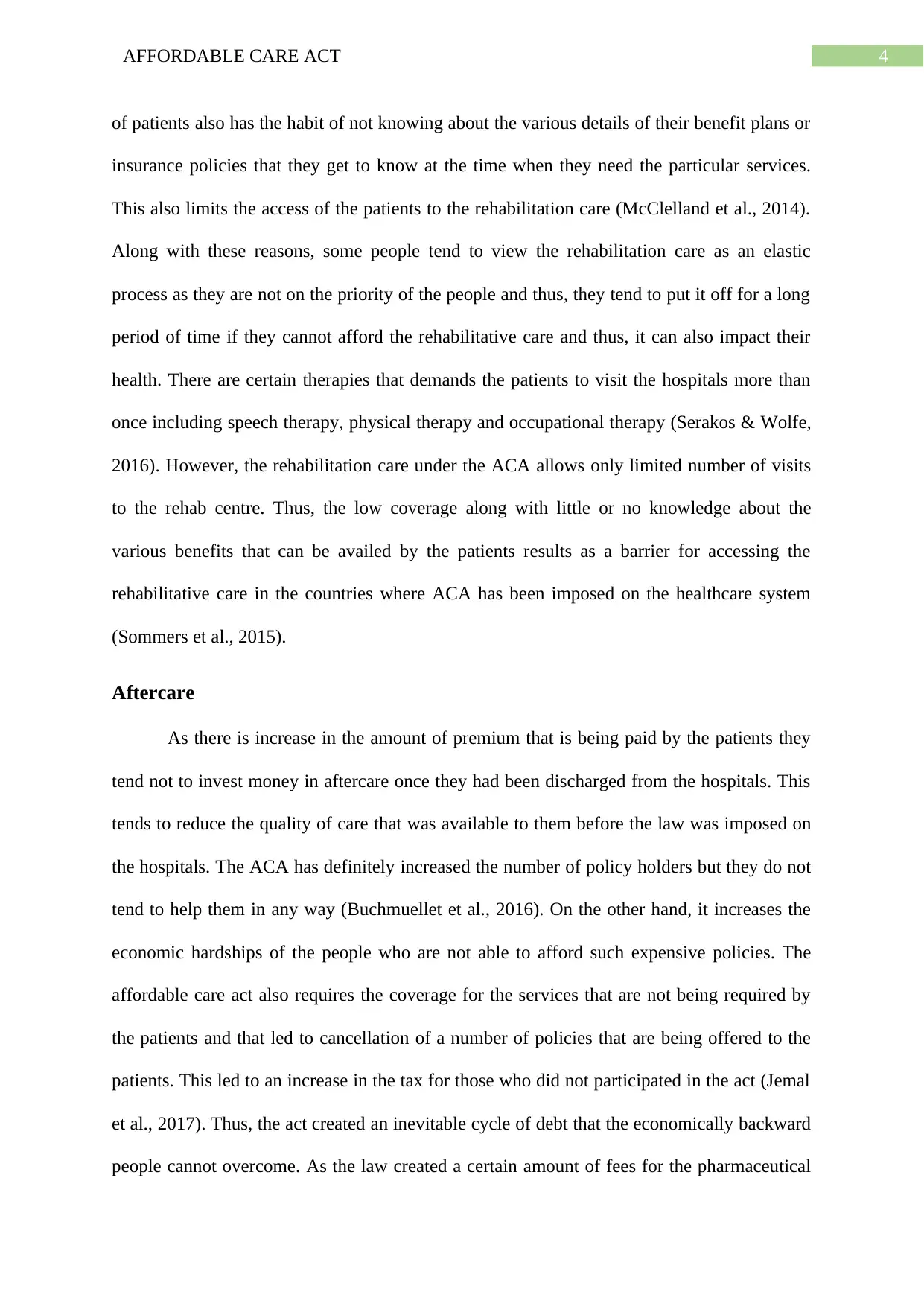
4AFFORDABLE CARE ACT
of patients also has the habit of not knowing about the various details of their benefit plans or
insurance policies that they get to know at the time when they need the particular services.
This also limits the access of the patients to the rehabilitation care (McClelland et al., 2014).
Along with these reasons, some people tend to view the rehabilitation care as an elastic
process as they are not on the priority of the people and thus, they tend to put it off for a long
period of time if they cannot afford the rehabilitative care and thus, it can also impact their
health. There are certain therapies that demands the patients to visit the hospitals more than
once including speech therapy, physical therapy and occupational therapy (Serakos & Wolfe,
2016). However, the rehabilitation care under the ACA allows only limited number of visits
to the rehab centre. Thus, the low coverage along with little or no knowledge about the
various benefits that can be availed by the patients results as a barrier for accessing the
rehabilitative care in the countries where ACA has been imposed on the healthcare system
(Sommers et al., 2015).
Aftercare
As there is increase in the amount of premium that is being paid by the patients they
tend not to invest money in aftercare once they had been discharged from the hospitals. This
tends to reduce the quality of care that was available to them before the law was imposed on
the hospitals. The ACA has definitely increased the number of policy holders but they do not
tend to help them in any way (Buchmuellet et al., 2016). On the other hand, it increases the
economic hardships of the people who are not able to afford such expensive policies. The
affordable care act also requires the coverage for the services that are not being required by
the patients and that led to cancellation of a number of policies that are being offered to the
patients. This led to an increase in the tax for those who did not participated in the act (Jemal
et al., 2017). Thus, the act created an inevitable cycle of debt that the economically backward
people cannot overcome. As the law created a certain amount of fees for the pharmaceutical
of patients also has the habit of not knowing about the various details of their benefit plans or
insurance policies that they get to know at the time when they need the particular services.
This also limits the access of the patients to the rehabilitation care (McClelland et al., 2014).
Along with these reasons, some people tend to view the rehabilitation care as an elastic
process as they are not on the priority of the people and thus, they tend to put it off for a long
period of time if they cannot afford the rehabilitative care and thus, it can also impact their
health. There are certain therapies that demands the patients to visit the hospitals more than
once including speech therapy, physical therapy and occupational therapy (Serakos & Wolfe,
2016). However, the rehabilitation care under the ACA allows only limited number of visits
to the rehab centre. Thus, the low coverage along with little or no knowledge about the
various benefits that can be availed by the patients results as a barrier for accessing the
rehabilitative care in the countries where ACA has been imposed on the healthcare system
(Sommers et al., 2015).
Aftercare
As there is increase in the amount of premium that is being paid by the patients they
tend not to invest money in aftercare once they had been discharged from the hospitals. This
tends to reduce the quality of care that was available to them before the law was imposed on
the hospitals. The ACA has definitely increased the number of policy holders but they do not
tend to help them in any way (Buchmuellet et al., 2016). On the other hand, it increases the
economic hardships of the people who are not able to afford such expensive policies. The
affordable care act also requires the coverage for the services that are not being required by
the patients and that led to cancellation of a number of policies that are being offered to the
patients. This led to an increase in the tax for those who did not participated in the act (Jemal
et al., 2017). Thus, the act created an inevitable cycle of debt that the economically backward
people cannot overcome. As the law created a certain amount of fees for the pharmaceutical
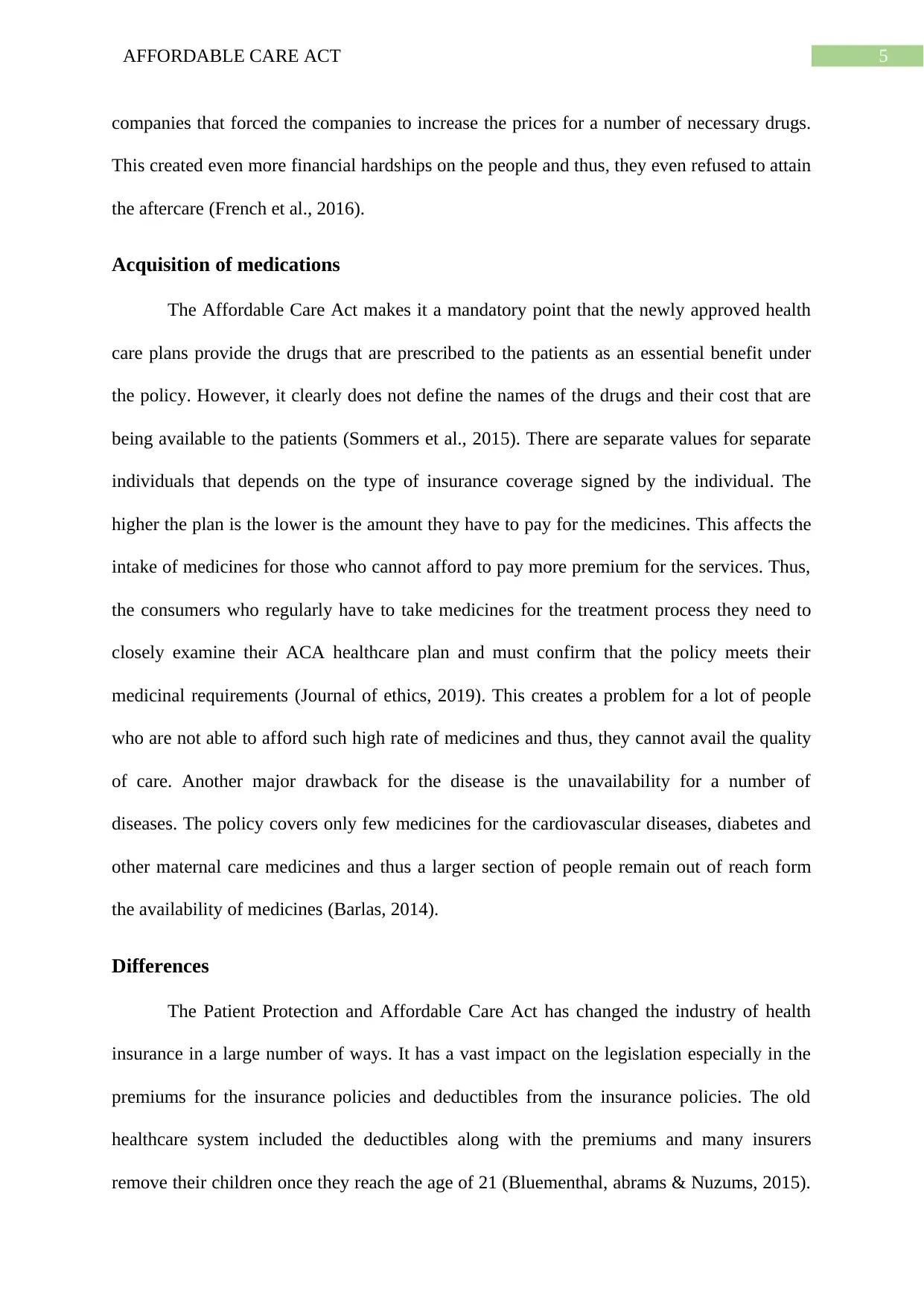
5AFFORDABLE CARE ACT
companies that forced the companies to increase the prices for a number of necessary drugs.
This created even more financial hardships on the people and thus, they even refused to attain
the aftercare (French et al., 2016).
Acquisition of medications
The Affordable Care Act makes it a mandatory point that the newly approved health
care plans provide the drugs that are prescribed to the patients as an essential benefit under
the policy. However, it clearly does not define the names of the drugs and their cost that are
being available to the patients (Sommers et al., 2015). There are separate values for separate
individuals that depends on the type of insurance coverage signed by the individual. The
higher the plan is the lower is the amount they have to pay for the medicines. This affects the
intake of medicines for those who cannot afford to pay more premium for the services. Thus,
the consumers who regularly have to take medicines for the treatment process they need to
closely examine their ACA healthcare plan and must confirm that the policy meets their
medicinal requirements (Journal of ethics, 2019). This creates a problem for a lot of people
who are not able to afford such high rate of medicines and thus, they cannot avail the quality
of care. Another major drawback for the disease is the unavailability for a number of
diseases. The policy covers only few medicines for the cardiovascular diseases, diabetes and
other maternal care medicines and thus a larger section of people remain out of reach form
the availability of medicines (Barlas, 2014).
Differences
The Patient Protection and Affordable Care Act has changed the industry of health
insurance in a large number of ways. It has a vast impact on the legislation especially in the
premiums for the insurance policies and deductibles from the insurance policies. The old
healthcare system included the deductibles along with the premiums and many insurers
remove their children once they reach the age of 21 (Bluementhal, abrams & Nuzums, 2015).
companies that forced the companies to increase the prices for a number of necessary drugs.
This created even more financial hardships on the people and thus, they even refused to attain
the aftercare (French et al., 2016).
Acquisition of medications
The Affordable Care Act makes it a mandatory point that the newly approved health
care plans provide the drugs that are prescribed to the patients as an essential benefit under
the policy. However, it clearly does not define the names of the drugs and their cost that are
being available to the patients (Sommers et al., 2015). There are separate values for separate
individuals that depends on the type of insurance coverage signed by the individual. The
higher the plan is the lower is the amount they have to pay for the medicines. This affects the
intake of medicines for those who cannot afford to pay more premium for the services. Thus,
the consumers who regularly have to take medicines for the treatment process they need to
closely examine their ACA healthcare plan and must confirm that the policy meets their
medicinal requirements (Journal of ethics, 2019). This creates a problem for a lot of people
who are not able to afford such high rate of medicines and thus, they cannot avail the quality
of care. Another major drawback for the disease is the unavailability for a number of
diseases. The policy covers only few medicines for the cardiovascular diseases, diabetes and
other maternal care medicines and thus a larger section of people remain out of reach form
the availability of medicines (Barlas, 2014).
Differences
The Patient Protection and Affordable Care Act has changed the industry of health
insurance in a large number of ways. It has a vast impact on the legislation especially in the
premiums for the insurance policies and deductibles from the insurance policies. The old
healthcare system included the deductibles along with the premiums and many insurers
remove their children once they reach the age of 21 (Bluementhal, abrams & Nuzums, 2015).
⊘ This is a preview!⊘
Do you want full access?
Subscribe today to unlock all pages.

Trusted by 1+ million students worldwide
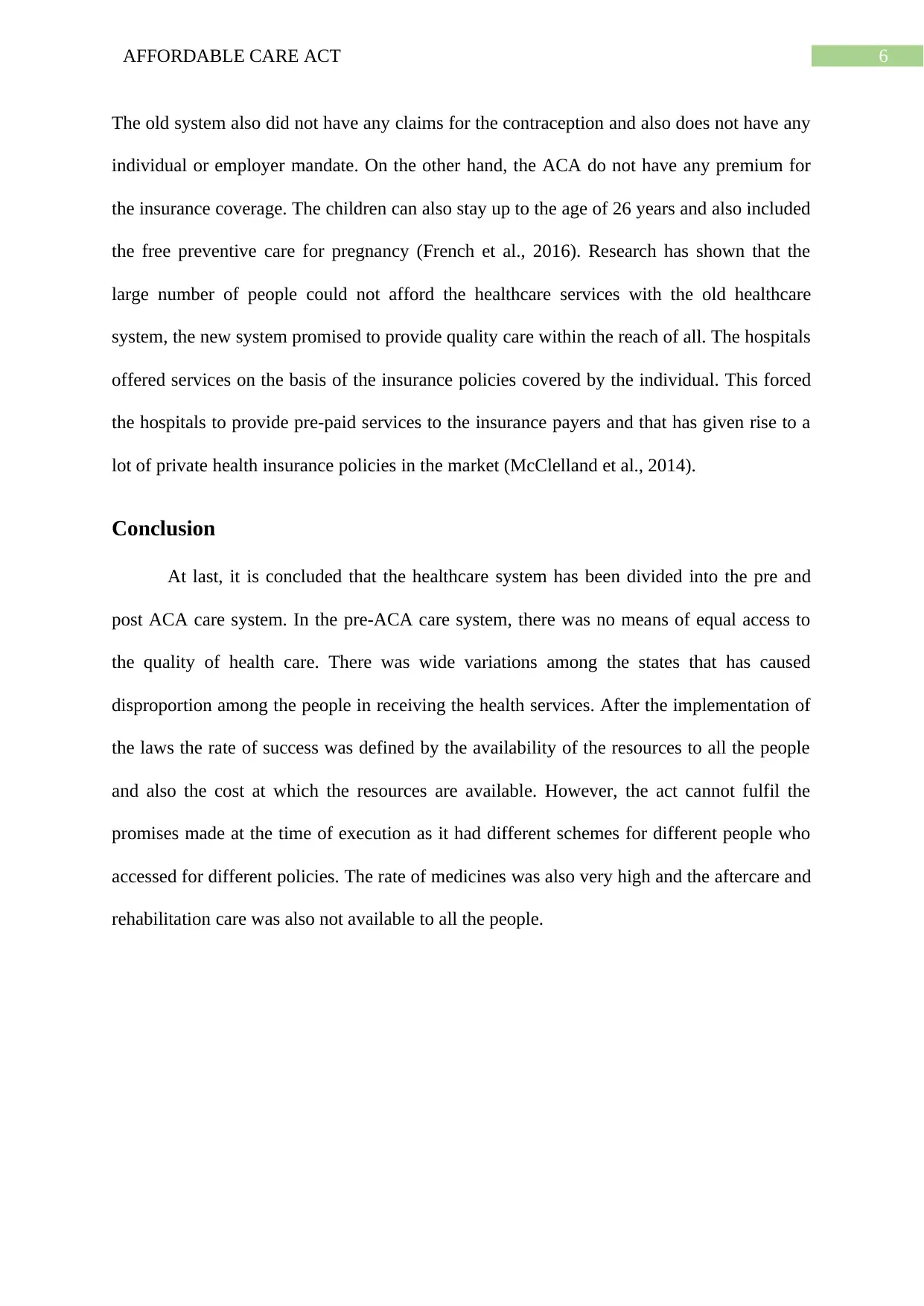
6AFFORDABLE CARE ACT
The old system also did not have any claims for the contraception and also does not have any
individual or employer mandate. On the other hand, the ACA do not have any premium for
the insurance coverage. The children can also stay up to the age of 26 years and also included
the free preventive care for pregnancy (French et al., 2016). Research has shown that the
large number of people could not afford the healthcare services with the old healthcare
system, the new system promised to provide quality care within the reach of all. The hospitals
offered services on the basis of the insurance policies covered by the individual. This forced
the hospitals to provide pre-paid services to the insurance payers and that has given rise to a
lot of private health insurance policies in the market (McClelland et al., 2014).
Conclusion
At last, it is concluded that the healthcare system has been divided into the pre and
post ACA care system. In the pre-ACA care system, there was no means of equal access to
the quality of health care. There was wide variations among the states that has caused
disproportion among the people in receiving the health services. After the implementation of
the laws the rate of success was defined by the availability of the resources to all the people
and also the cost at which the resources are available. However, the act cannot fulfil the
promises made at the time of execution as it had different schemes for different people who
accessed for different policies. The rate of medicines was also very high and the aftercare and
rehabilitation care was also not available to all the people.
The old system also did not have any claims for the contraception and also does not have any
individual or employer mandate. On the other hand, the ACA do not have any premium for
the insurance coverage. The children can also stay up to the age of 26 years and also included
the free preventive care for pregnancy (French et al., 2016). Research has shown that the
large number of people could not afford the healthcare services with the old healthcare
system, the new system promised to provide quality care within the reach of all. The hospitals
offered services on the basis of the insurance policies covered by the individual. This forced
the hospitals to provide pre-paid services to the insurance payers and that has given rise to a
lot of private health insurance policies in the market (McClelland et al., 2014).
Conclusion
At last, it is concluded that the healthcare system has been divided into the pre and
post ACA care system. In the pre-ACA care system, there was no means of equal access to
the quality of health care. There was wide variations among the states that has caused
disproportion among the people in receiving the health services. After the implementation of
the laws the rate of success was defined by the availability of the resources to all the people
and also the cost at which the resources are available. However, the act cannot fulfil the
promises made at the time of execution as it had different schemes for different people who
accessed for different policies. The rate of medicines was also very high and the aftercare and
rehabilitation care was also not available to all the people.
Paraphrase This Document
Need a fresh take? Get an instant paraphrase of this document with our AI Paraphraser
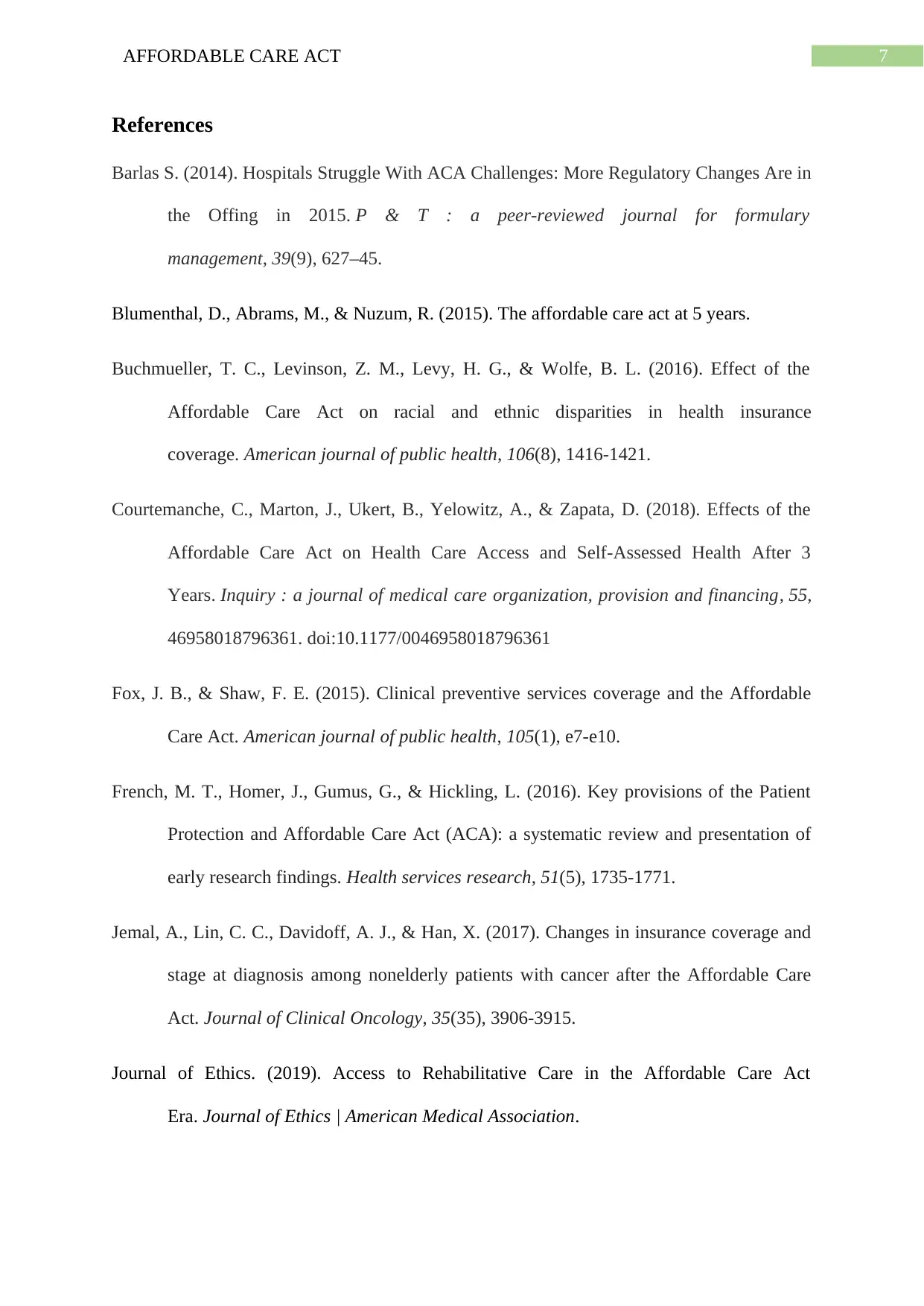
7AFFORDABLE CARE ACT
References
Barlas S. (2014). Hospitals Struggle With ACA Challenges: More Regulatory Changes Are in
the Offing in 2015. P & T : a peer-reviewed journal for formulary
management, 39(9), 627–45.
Blumenthal, D., Abrams, M., & Nuzum, R. (2015). The affordable care act at 5 years.
Buchmueller, T. C., Levinson, Z. M., Levy, H. G., & Wolfe, B. L. (2016). Effect of the
Affordable Care Act on racial and ethnic disparities in health insurance
coverage. American journal of public health, 106(8), 1416-1421.
Courtemanche, C., Marton, J., Ukert, B., Yelowitz, A., & Zapata, D. (2018). Effects of the
Affordable Care Act on Health Care Access and Self-Assessed Health After 3
Years. Inquiry : a journal of medical care organization, provision and financing, 55,
46958018796361. doi:10.1177/0046958018796361
Fox, J. B., & Shaw, F. E. (2015). Clinical preventive services coverage and the Affordable
Care Act. American journal of public health, 105(1), e7-e10.
French, M. T., Homer, J., Gumus, G., & Hickling, L. (2016). Key provisions of the Patient
Protection and Affordable Care Act (ACA): a systematic review and presentation of
early research findings. Health services research, 51(5), 1735-1771.
Jemal, A., Lin, C. C., Davidoff, A. J., & Han, X. (2017). Changes in insurance coverage and
stage at diagnosis among nonelderly patients with cancer after the Affordable Care
Act. Journal of Clinical Oncology, 35(35), 3906-3915.
Journal of Ethics. (2019). Access to Rehabilitative Care in the Affordable Care Act
Era. Journal of Ethics | American Medical Association.
References
Barlas S. (2014). Hospitals Struggle With ACA Challenges: More Regulatory Changes Are in
the Offing in 2015. P & T : a peer-reviewed journal for formulary
management, 39(9), 627–45.
Blumenthal, D., Abrams, M., & Nuzum, R. (2015). The affordable care act at 5 years.
Buchmueller, T. C., Levinson, Z. M., Levy, H. G., & Wolfe, B. L. (2016). Effect of the
Affordable Care Act on racial and ethnic disparities in health insurance
coverage. American journal of public health, 106(8), 1416-1421.
Courtemanche, C., Marton, J., Ukert, B., Yelowitz, A., & Zapata, D. (2018). Effects of the
Affordable Care Act on Health Care Access and Self-Assessed Health After 3
Years. Inquiry : a journal of medical care organization, provision and financing, 55,
46958018796361. doi:10.1177/0046958018796361
Fox, J. B., & Shaw, F. E. (2015). Clinical preventive services coverage and the Affordable
Care Act. American journal of public health, 105(1), e7-e10.
French, M. T., Homer, J., Gumus, G., & Hickling, L. (2016). Key provisions of the Patient
Protection and Affordable Care Act (ACA): a systematic review and presentation of
early research findings. Health services research, 51(5), 1735-1771.
Jemal, A., Lin, C. C., Davidoff, A. J., & Han, X. (2017). Changes in insurance coverage and
stage at diagnosis among nonelderly patients with cancer after the Affordable Care
Act. Journal of Clinical Oncology, 35(35), 3906-3915.
Journal of Ethics. (2019). Access to Rehabilitative Care in the Affordable Care Act
Era. Journal of Ethics | American Medical Association.
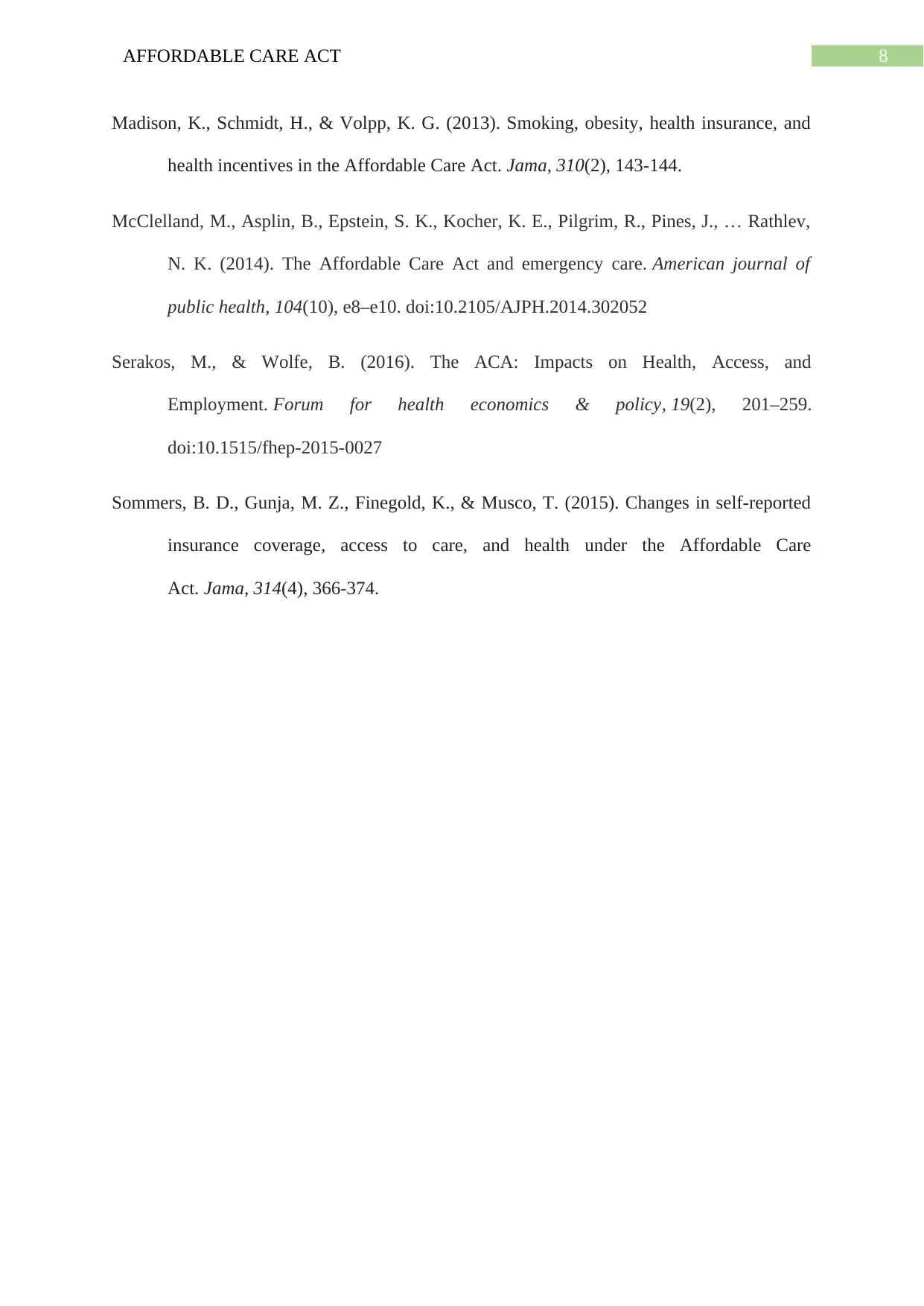
8AFFORDABLE CARE ACT
Madison, K., Schmidt, H., & Volpp, K. G. (2013). Smoking, obesity, health insurance, and
health incentives in the Affordable Care Act. Jama, 310(2), 143-144.
McClelland, M., Asplin, B., Epstein, S. K., Kocher, K. E., Pilgrim, R., Pines, J., … Rathlev,
N. K. (2014). The Affordable Care Act and emergency care. American journal of
public health, 104(10), e8–e10. doi:10.2105/AJPH.2014.302052
Serakos, M., & Wolfe, B. (2016). The ACA: Impacts on Health, Access, and
Employment. Forum for health economics & policy, 19(2), 201–259.
doi:10.1515/fhep-2015-0027
Sommers, B. D., Gunja, M. Z., Finegold, K., & Musco, T. (2015). Changes in self-reported
insurance coverage, access to care, and health under the Affordable Care
Act. Jama, 314(4), 366-374.
Madison, K., Schmidt, H., & Volpp, K. G. (2013). Smoking, obesity, health insurance, and
health incentives in the Affordable Care Act. Jama, 310(2), 143-144.
McClelland, M., Asplin, B., Epstein, S. K., Kocher, K. E., Pilgrim, R., Pines, J., … Rathlev,
N. K. (2014). The Affordable Care Act and emergency care. American journal of
public health, 104(10), e8–e10. doi:10.2105/AJPH.2014.302052
Serakos, M., & Wolfe, B. (2016). The ACA: Impacts on Health, Access, and
Employment. Forum for health economics & policy, 19(2), 201–259.
doi:10.1515/fhep-2015-0027
Sommers, B. D., Gunja, M. Z., Finegold, K., & Musco, T. (2015). Changes in self-reported
insurance coverage, access to care, and health under the Affordable Care
Act. Jama, 314(4), 366-374.
⊘ This is a preview!⊘
Do you want full access?
Subscribe today to unlock all pages.

Trusted by 1+ million students worldwide
1 out of 9
Related Documents
Your All-in-One AI-Powered Toolkit for Academic Success.
+13062052269
info@desklib.com
Available 24*7 on WhatsApp / Email
![[object Object]](/_next/static/media/star-bottom.7253800d.svg)
Unlock your academic potential
Copyright © 2020–2025 A2Z Services. All Rights Reserved. Developed and managed by ZUCOL.





